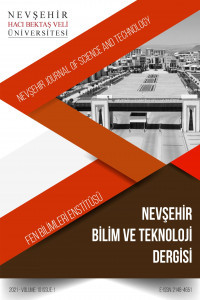Ultrasonik Aktifleştirilmiş Aktif Karbon ile Krom (VI) Adsorpsiyonu
Bu çalışmada, sulu çözeltilerden Cr (VI)’nın ham ve ultrasonik aktiflenmiş ticari aktif karbon ile giderimi araştırılmıştır. Farklı dozlardatemas süresinin ve çözelti pH’ının etkinliği incelenmiştir. Adsorpsiyon sürecinin Freundlich ve Langmuir izotermlerine uygunluklarıaraştırılmıştır. Sonuç olarak, 120 dakikalık temas süresinin yeterli olduğu görülmüştür. pH 2’de en yüksek verim elde edilirken, pHyükseldikçe adsorpsiyon veriminin düştüğü belirlenmiştir. pH 2’de, 25 °C sıcaklıkta, 200 rpm karıştırma hızında, 25 mg/L Cr (VI) çözeltisiile 200 mg/L aktif karbon ile yapılan deneylerde, ham aktif karbonun adsorpsiyon kapasitesi 100 mg/g iken, 20 kHz frekansta 100 Wultrasonik güçte 10 dk süreyle ultrasonik işlem sonucunda 111 mg/g’a yükselmiştir. Böylece aktif karbonun adsorpsiyon kapasitesi,ultrasonik ön işlem ile arttırılmıştır. Cr (VI)’nin ham ve aktiflenmiş aktif karbon ile adsorpsiyonu için, Langmuir izoterminin uygun olduğubelirlenmiştir.
Anahtar Kelimeler:
Adsorpsiyon, aktif karbon, akustik kavitasyon, krom (VI), ultrases
In this study, removal of Cr(VI) with raw and ultrasonic activated commercial active carbon was investigated. The effect of contact time and solution pH at different dosages was examined. The fitting of adsorption period for Freundlich and Langmuir isotherms was determined. As a result, it was observed that 120 minute-contact time was sufficient. While maximum efficiency was obtained at pH 2, it was determined that adsorption efficiency decreased as pH increased. In the experiment performed with 200 mg/L active carbon in 25 mg/L Cr (VI) solution at pH 2, 25°C temperature and 200 rpm stirring speed, adsorption capacity of raw active carbon was 100 mg/g while it was increased to 111 mg/g as a result of 10 minute-ultrasonic process at 20 kHz frequency and with 100 W ultrasonic power. Thus, adsorption capacity of active carbon was improved with ultrasonic pretreatment. It was determined that Langmuir isotherm was suitable for the adsorption of Cr(VI) with raw and activated active carbon.
Keywords:
Acoustic cavitation, activated carbon, adsorption, chromium (VI), ultrasound,
___
- Cimino G., Caristi C., Acute Toxicity of Heavy Metals to Aerobic Digestion of Waste Cheese Whey, Biological Wastes, 33, 201–210, 1990.
- Madoni P., Davoli D., Gorbi G., Vescovi L., Toxic Effect of Heavy Metals on the Activated Sludge Protozoan Community, Water Research, 30, 135–142, 1996.
- IPCS (International Programme on Chemical Safety), Environmental Health Criteria 61, Chromium WHO, Geenva, 1988.
- Levankumar L., Muthukumaran V., Gobinath M.B., Batch Adsorption and Kinetics of Chromium (VI) Removal from Aqueous Solutions by Ocimum Americanum L. Seed Pods, Journal of Hazardous Materials, 161, 709 – 713 , 2009.
- Dakiky M., Khamis M., Manassra A., Mer'eb M., Selective Adsorption of Chromium (VI) in Industrial Wastewater Using Low-cost Abundantly Available Adsorbents, Advances in Environmental Research, 6, 533 – 540, 2002.
- Andelib Aydın Y., Deveci Aksoy N., Adsorption of Chromium on Chitosan: Optimization, Kinetics and Thermodynamics, Chemical Engineering Journal, 151, 188 – 194, 2009.
- AL-Othman Z.A., Ali R., Naushad M., Hexavalent Chromium Removal from Aqueous Medium by Activated Carbon Prepared from Peanut Shell: Adsorption Kinetics, Equilibrium and Thermodynamic Studies, Chemical Engineering Journal, 184, 238 – 247, 2012.
- Neis U., Nickel K., Schlammbehandlung mit Ultraschall - ein aktuelles Leistungsbild. In: 2. ATVDVWK-Klärschlammtage, Würzburg-Hennefi,2001.
- Breitbach M., Bathen D., Influence of Ultrasound on Adsorption Processes, Ultrasonics Sonochemistry, 8,277 – 283, 2001.
- Jing G., Zhou Z., Song L., Dong M., Ultrasound Enhanced Adsorption and Desorption of Chromium (VI) on Activated Carbon and Polymeric Resin, Desalination, 279, 423 – 427, 2011.
- APHA, Standart Methods for examination of water and wastewater. American Water Work Association, New York, 1992.
- Malkoc E., Nuhoglu Y., Dundar M. Adsorption of Chromium(VI) on Pomace—An Olive Oil Industry Waste: Batch and Column Studies. Journal of Hazardous Materials, 138, 142 – 151, 2006.
- ISSN: 2148-466X
- Yayın Aralığı: Yılda 2 Sayı
- Başlangıç: 2012
- Yayıncı: Nevşehir Hacı Bektaş Veli Üniversitesi
Sayıdaki Diğer Makaleler
Gıda Patojenlerinin Tanısında Kullanılan NanoBoyutlu İmmünosensör Tasarımı
Ultrasonik Aktifleştirilmiş Aktif Karbon ile Krom (VI) Adsorpsiyonu
Araç Çayı Makroomurgasızları Üzerine Bir Ön Çalışma
Borlama İşleminde Kullanılan Bor Tozu Tane Boyutunun Kaplama Tabakası Üzerine Etkisi
As (III)’ün As (V)’e Ultrasonik Oksidasyonu
Erdogan ÇİÇEK, Sevil BİRECİKLİGİL, Fadime ÇELEKLİ, Abuzer ÇELEKLİ
Hatice Özlem İNCE, Cengiz BAHADIROĞLU, Sevil TOROĞLU, Hakan BOZDOĞAN
